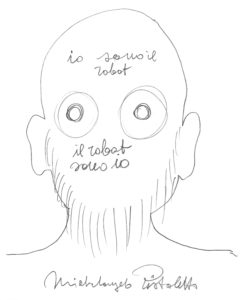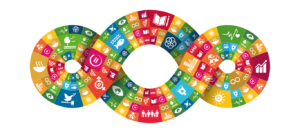Here we are. The moment has come: today – Sunday 13th October – is the day of the 22nd edition of the event presenting exhibitions, conferences and seminars about artistic practices of transformation of the social context in which they are developed, realised by Cittadellarte and the international network it has built throughout the years. We are talking about Arte al Centro (Art at the Centre), which will start at 16.00 with the opening of the exhibitions and the first treatments of the Terme Culturali, and the debate The key themes to work on for the development of a territory starting from culture and art* (at 16.30). The official inauguration will be at 18.30, when the newly restored spaces of industrial archaeology below the permanent seat of the Third Paradise will open to the public. Paolo Naldini, director of Cittadellarte, and Michelangelo Pistoletto will officially introduce the event with their speeches. The Biellese artist has shared his thoughts with us, in the course of an interview mainly focusing on Arte al Centro.
In 1967 you opened your studio to artists from every vocation and trend: poets, theatre actors, film makers, musicians. Arte al Centro, too, features a great variety of productions: installations, sound works, the treatments of the Terme Culturali, the project of sustainable fashion B.E.S.T., the annual award Minimum Prize, films, conferences, performances and much more. Your and Cittadellarte’s proposal continues to bring together different languages: how important is it to gather in a single place the different actors and themes of the world of art?
After opening my studio in 1967, I kept extending the encounters and interconnections beyond the artistic languages to the different sectors composing society. Cittadellarte is the place where artistic activities intertwine with the practices of social life, producing synergies expanded to every dimension of the civil fabric.
In the ’60s we left the places formally destined to art like studios, galleries, museums and theatres, to enter real life as experienced in the streets. Cittadellarte is now an institution in which to fulfil the aspirations and the objectives we were aiming at when we broke with the traditional institutions. Cittadellarte is a laboratory of civilisation, its research consists in fact in progressing from Cittadellarte to the “Civilization of Art”.
One of the main novelties of this year’s Arte al Centro is the Terme Culturali. Why is the theme of water assuming such a key role in this context?
Water is a source of life. Where there’s no water there is desert. The word ‘paradise’ itself is linked to this element. In ancient Persian the term ‘paradise’ meant ‘protected garden’. They were circular stone walls, built in desert areas to protect the internal space from the strong winds, thus allowing the night humidity to make the vegetation grow.
In some religions, this architectural device has then assumed a miraculous meaning and water has become ‘holy water’. The Third Paradise assumes the meaning of protected garden and applies it to a planetary dimension: saving the Earth from the degradation caused by mankind is now the miracle mankind itself must perform.
Water, as essence of life, is the symbol of generation and regeneration that Cittadellarte adopts with the Terme Culturali. Starting from mother water to save the Earth. This means acting on all the branches of culture to take water back to its practical usefulness like in the Garden of Eden.

You have recently realised the work Autoritratto 2019 (Self-Portrait 2019, pictured below), in which you wrote “I am the robot, the robot is me”. The image chosen for the communication of Arte al Centro is a robot, created as part of the film The Human Tools by Nico Angiuli. Does this attention to robots reveal a critic to a society now dependent on technology? If we take your sign-symbol as point of reference, is the artificial paradise becoming bigger than the natural one?
With the use of algorithms, robotics has become the technological mirror of reality. In my work, I have identified the reflection of images as a phenomenon of truth: the mirror represents in fact reality as it is, it can’t lie. The algorithmic and robotic science is creating a technological mirror reproducing what exists in its own being. “I am the robot, the robot is me” means that I am myself made like the robot I’ve built, it represents me phenomenologically.
Let’s consider the myth of Narcissus. Looking into the water (a recurring element), Narcissus sees an image of himself, but he doesn’t recognise it as such and falls in love with that image, so much so that he drowns in it. It might sound unbelievable, but that ancient myth was already somehow referring to the present man, who, as well as in art, is now looking at his own reflection in technology. The mythical story could finally become true, and man, falling in love with his technological image rather than keeping his distances from it, might end up drowning in the technology representing him. After working with the mirror reflecting images, my task as an artist is to deal with a mirror reflecting physical and practical life. We can put these two mirrors in the two external circles of the Third Paradise, and place our acquisition of knowledge, awareness and responsibility in the central one.

As usual, Arte al Centro will take place in Biella, but involve guests and speakers of international calibre like Pier Luigi Sacco (Special Adviser to the Commissioner for Education and Culture of the European Commission), who will take part in the conference “The key themes to work on for the development of a territory starting from culture and art”, and Gianni Rosas (General Director of ILO Italy), who will attend the debate after the screening of the film Il Patto della Montagna (The pact of the mountain). How important is it to foster the relationship with these institutions in achieving the 17 Sustainable Development Goals from the UN’s 2030 Agenda?
We can boast of having been the firsts to activate the functions of the UN’s 17 Sustainable Development Goals when, in 2015, we took them to the first Rebirth/Third Paradise Forum in Havana (Cuba). I must also reiterate that that is the direction Cittadellarte has been moving in since the very beginning anyway, our mission is in fact “to stimulate and produce a responsible transformation of society” and the event Arte al Centro places art at the centre of this transformation, which in English is called “sustainability” and in French “durability”. Conferences and debates are a constant feature of Cittadellarte’s activities throughout the year. For this year’s edition of Arte al Centro, too, we can rely on the participation of highly valued figures who will contribute with their knowledge and their experience to the programme of sustainable innovation we are carrying out.

This is the 22nd edition of Arte al Centro. What does this event represent for you? How do you think it has evolved through time?
This 22nd edition of Arte al Centro represents a meaningful passage in Cittadellarte’s evolution. First of all, it launches a new articulated and participated system of visit to the complex. Second, it marks the opening of the Terme Culturali, which will extend to a short-stay format. Third, it is an opportunity to meet and discuss with Rebirth / Third Paradise ambassadors about the development of the project The Art of Demopraxy. Fourth, it presents the specificities of the UNIDEE Academy through the guests’ speeches.
To summarise, I can confirm that the future of Cittadellarte rests on three basic elements: the new UNIDEE Academy, dedicated to training the protagonists of the new society; the establishment for artistic, cultural and social cure called Terme Culturali; and the development and strengthening of the work of social regeneration based on the method of Demopraxy, offering itself as an alternative to the one used so far to accomplish democracy. We intend to conduct our activity along these three lines.

